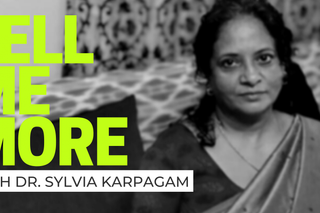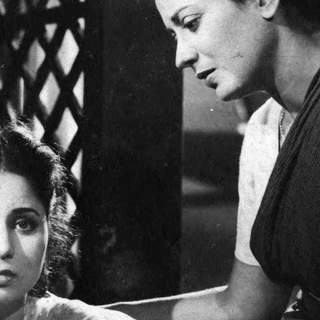
Tell Me More: Talking How Caste And Gender Influence Access to Health With Dr. Sylvia Karpagam
“None of us see this as a social problem that deserves attention and participation because, well, how many of us are choosing hospitals by virtue of how well they treat their workers?”

In The Swaddle’s interview series Tell Me More, we discuss crucial cultural topics with people whose work pushes societal boundaries.
Dr. Sylvia Karpagam is a public health researcher and a doctor, with a focus on public health systems and the social determinants of health in India. The Swaddle’s Aditi Murti spoke with Dr. Karpagam about how caste and gender influence access to health and nutrition in India.
The Swaddle: The Covid19 pandemic highlighted an often-glossed-over issue — the continued lack of attention paid to health and sanitation workers who are placed in harm’s way to do jobs like disposing of biomedical waste without adequate protective equipment. How does the system prevent these workers from advocating for themselves?
Dr. Sylvia Karpagam: Our healthcare system is heavily fragmented and doctor-centric. This doctor is often a dominant caste male doctor, and everyone else is secondary. This is never how a healthcare system should be — for example, it would be very difficult for a doctor to function without a pharmacist or a nurse. Often, the people who are most ignored in this structure are people who work to maintain the hospital — the housekeeping staff, the people working in mortuaries, the ambulance drivers, and the sanitation workers who handle to hospital waste.
Most of these workers are from Dalit communities and are taken on a contract basis. They don’t benefit from labor laws and face exploitation, threats, and harassment if they attempt to unionize. Union leaders are bullied and thrown out of their jobs. Yes, there are social and legal mechanisms that ensure that exploitation doesn’t happen, but many of such mechanisms are not accessible to these workers. This became worse during the pandemic — we spoke to a lot of workers and realized they didn’t have basic even basic PPE kits or ergonomically designed equipment — India may boast about how technologically advanced it is, but look at the carts full of waste that workers have to push. Imagine the effect this work would have on their health. Even then, these workers do not receive work-related healthcare support or insurance, or even basic protective equipment. When these workers died of Covid19, they didn’t receive any compensation either. I think this is a huge issue from both a public health, occupational hazards and a labor laws perspective — a lot of this happens to Dalit women and we need to take cognizance of it.
But none of us see this as a social problem that deserves attention and participation because, well, how many of us are choosing hospitals by virtue of how well they treat their workers?
TS: You mentioned that the healthcare system is quite doctor-centric in India. Could you elaborate on that?
SK: When HIV happened in India, there was some discussion about moving healthcare from a doctor-centric model to a more comprehensive model — where all players within the system become equally important. You have a patient at the center of it all, and everyone providing services to the patient is an equal player. I think that’s a better approach because it challenges the myth that the doctor is an all powerful God.. It also influences how doctors respond to regulation — a couple of years back the government tried to bring about regulations to make sure private hospitals don’t charge exorbitantly, and doctors took to the streets to protest saying, “We are not terrorists, why should we be regulated?” Dealing with life and people is a huge responsibility, and it also means huge accountability.
In government hospitals, accountability is slightly better because you have district and state-level officials to complain to. Private hospitals are practically only regulated by the media reporting on negligence or denial of care or these hospitals charging exorbitant costs. So changing these systems is necessary to make healthcare more holistic and comprehensive.
TS: There’s been quite a bit of tussle between allopathic doctors and AYUSH doctors, especially as the latter took up space during Covid19. How do we make space for a holistic system under these conditions?
SK: In some situations, there are communities and groups that would choose AYUSH doctors over allopathic doctors for several reasons. The concern is about AYUSH doctors practicing allopathic healthcare. A lot of these non-allopathic doctors are dispensing drugs, giving injections and performing procedures. Even if these cases might be successful, there’s a significant potential of complications and a lot of these doctors are not trained to handle that. That’s definitely a fair concern.
But at the same time, allopathic doctors do not make room for any alternative systems of medicine. If patients had the option of homeopathy, Siddha, Ayurveda, Yoga, Unani and allopathy under the same roof, the government would be able to keep a check and ensure that all systems of medicine are evidence-based . For example, if you’re at a hospital with a severe back problem and the allopathic doctor tells you that you need surgery, the patient, you also have the option to at least try pain management practices like yoga as an alternative. But that’s not possible in this environment due to it being so highly competitive.
TS: You’d previously mentioned that the doctor at the top of a system is almost always a Brahmin male doctor. That made me curious about how individuals from dominant castes control access to health information and treatment in India?
SK: Beyond the confines of a hospital, there are several social determinants that influence public health. These include gender, education, shelter, sanitation, nutrition, public transport, livelihood, and more. Caste and gender play prominent roles in being a barrier between marginalized people and access to health. The further the healthcare system is, the less likely women are to access it but this is not factored into planning. For example, we know that the education of mothers is positively linked to child health and nutrition but decision-makers aren’t talking about that. Instead, they almost blame marginalized communities as if they are responsible for their own ill-health. We’ve had instances of the government trying to bring in odd policies like increasing the age of marriage to 21 in order to reduce malnutrition, knowing very well that there are several problems that can arise from increasing the age of marriage.
Then, if you look at the way policies around livelihood and minimum wage are calculated, their focus on nutrition is primarily accounting for a cereal-centric diet. There’s very little budgeting for foods like meat, eggs, and milk — you know, the things people need to eat to be healthy. It’s the same with sanitation — there’s a lot of visionary talks, but in reality, who’s cleaning your sewage system? When you put together single pit latrines, who has to clean them? Same with public transport — consider who cities are designed for and how people like street vendors are targeted.
I think all of these determinants contribute to understanding how policy caters to a narrow class group. Another example is the Covid19 lockdown — people who were upper class were very happy with the idea of “social” distancing, but look at the serious effect it had on people’s homes, health and livelihood. Doctors from corporate hospitals said shut everything down, and turn large secondary and tertiary public hospitals into secondary Covid19 facilities, with large private hospitals acting as super-specialized Covid19 treatment facilities. Think: who needs access to these public facilities? Another well-known cardiologist said, “Shut down all public toilets!” — what are people who frequently use public toilets supposed to do? There’s actually such little thought placed in these decisions, and they’re also unscientific in a sense. I think most of the decisions were completely class and caste-based. And I think that adversely affected a huge, huge number of people and no one is going to be held accountable for it.
TS: You’d also worked with the fourth edition of the National Family Health Survey. From your experience, what problems come up during data collection that leads to NFHS data being unreliable/poor in quality?
SK: Although there are government facilities, the NFHS survey is contracted out to private agencies — some are like market research agencies who don’t have experience of collecting health related data. There’s also a lot of funding and influence from western organizations like the Gates Foundation — as experts, they should share their expertise but it’s a bit odd that they played such an important role in deciding what data we should collect and how we should collect it. A lot of the questions were focused on brands — like what company do families get insecticide treated mosquito nets from? Not sure why that data was collected and how its useful.
We also saw a lot of labor law violations. Individuals conducting these surveys do not receive the salaries printed on their contracts, work seven days a week. A lot of the people employed had no experience of doing surveys and were working without a proper structure in place for data collection. Naturally, under these conditions, the quality of data definitely suffers.Beyond that, there’s no system in place to bring in specific data — for example we should have more longitudinal data so that we could actually compare trends over a period of time. This requires investment, training and resources.
Another important point to highlight is that private hospitals which provide 60-70% of the healthcare don’t share data about mortality or morbidity with the government,. For example, hysterectomy rates are pretty high in private hospitals in India but there’s no monitoring system via which we can regulate them. We also don’t get enough estimates of the heights and weights of children in order to track malnutrition because these are not recorded accurately,.
TS: With respect to nutrition, there’s also controversial religion and caste-based influences in policies that provide something like daily mid-day meals. How does this influence occur in what’s supposed to be an impartial policy?
SK: When the National Food Security Act (2013) was introduced, it was envisaged to meet at least a third of a child’s nutritional needs. This is a legal mandate — that depending on the age of the child, they should receive around 450 -700 calories and 12-20 grams of protein in one meal. This meal should be provided in a government school as a mid-day meal, in order to encourage kids to each together and make use of local resources, making it culturally relevant.
The idea of cultural relevance is important. If I eat rice and sambar daily, but my workplace provides me with only rotis instead — I’m not going to want to eat it. It’s important that children eat what they’re used to eating at home, in order to encourage traditional foods from resources within the area as it makes the cost of food cheaper and gets children connected to local cultures.
Although food is mandated to be cooked in the school, there is a clause which allows for it to be provided from outside if there is no space for cooking in the school. Using this clause, now large corporates have stepped in — the largest provider is Akshaya Patra.Now they come with a clear ideological bent — they say there should be no meat, onion, and garlic in food. Beyond just that, we’ve also heard of several instances where children were exposed to propaganda from organizations like these. In fact, a study shows that onion and garlic improve the bioavailability of zinc and iron, and Indian children face deficiencies in both.
Now a lot of people argue that Akshaya Patra is very hygienic. Why assume that school cooked meals are less hygienic?,. But, another major issue is that a lack of onion and garlic affects the taste of the food served. This is actually something documented by State Food Commissions set up under the Food Security Act. They visited many schools and received several complaints from parents and students about how they’re unhappy with the meals. But, these organizations continue to get these contracts because the systems that support them are much bigger than children and their mothers who demand better food for their children.
As for the religious reasons involved in not providing eggs in mid-day meals, well look at the politics around it. The religious groups that don’t eat eggs mostly don’t study in government schools — these schools are more often occupied by children who eat meat, onion, garlic and eggs. So whose religious concerns are these really? Clearly a minority that holds power and political influence is dictating what children should not eat.
TS: How does this affect the children beyond the lack in diverse foods to provide nutrition?
SK: Children go home with these ideologies, right? Parents have complained that children come home and repeat ideological propaganda like garlic is bad for health, or meat will lead to a lack of concentration in studies. Students are told that they should eat vegetarian food in order to develop their brains and get good marks. None of this comes from any scientific basis, it only comes from prejudice. Children can’t take the meats that they eat at home to school. They refuse because it leads to ostracization — children are made to feel like they’re doing something disgusting. When we asked children why they don’t want to demand eggs in school, they say, “We should respect others.” But respect only flows one way. Everyone needs to respect vegetarians, but vegetarians are completely disrespectful of the eating habits of others.
This interview has been edited and condensed for clarity.
Aditi Murti is a culture writer at The Swaddle. Previously, she worked as a freelance journalist focused on gender and cities. Find her on social media @aditimurti.
Related


The Fursat Series Documents Women’s Small Moments of Resistance Via Leisure
